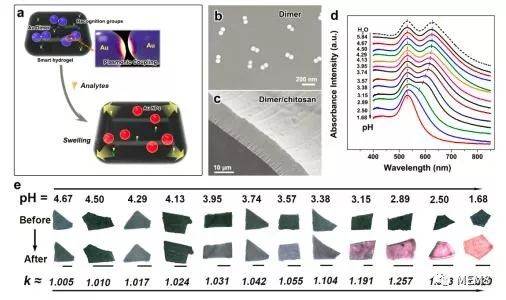Recently, a team led by Li Yue from the Micro-Nano Technology and Devices Research Institute at the Institute of Solid State Physics, Chinese Academy of Sciences, along with Deng Zhaoxiang, Li Liangbin from the University of Science and Technology of China, and Li Cuncheng from Jinan University, has made significant progress in the assembly of plasmon-coupled gold nanosphere dimers for colorimetric sensing. Their findings were recently published in the journal Advanced Functional Materials.

This research focuses on a colorimetric sensor device that integrates Au dimers with chitosan hydrogels. Colorimetric sensing is a technique that relies on changes in optical properties—such as absorption or emission—to detect analytes visually. It offers advantages like portability, ease of use, and real-time on-site monitoring, making it increasingly popular in various fields. In recent years, numerous sensors based on noble metal nanoparticles have been developed for detecting heavy metals, food additives, and toxic substances. However, traditional methods often suffer from issues like low sensitivity, instability, and uncontrollable nanoparticle aggregation, which limit their practical applications.
To address these challenges, the research team developed large-scale, high-quality gold nanosphere dimers by first synthesizing uniform monodisperse gold nanospheres. They then introduced a novel approach by combining these dimers with smart hydrogels. This strategy leverages the unique optical properties of Au dimers, such as their high sensitivity and tunable gap-dependent behavior, to create a highly sensitive and stable colorimetric sensor. The hydrogel’s ability to expand or contract in response to external stimuli allows precise control over the optical characteristics of the Au dimer, enabling accurate and reliable detection. Moreover, embedding the Au dimers within the hydrogel matrix prevents unwanted aggregation and sedimentation, significantly improving the sensor's stability.
The team further optimized the system by utilizing the inverse relationship between the hydrogel’s degree of swelling and its sensitivity to cross-linking. This allowed for a wide dynamic range of sensitivity, making the device suitable for detecting target analytes across different concentration levels. This innovative work not only advances the understanding of plasmon coupling in gold nanosphere dimers but also opens new possibilities for developing ultra-sensitive and stable sensor systems. The study was supported by several funding agencies, including the National Key Research and Development Program, the National Natural Science Foundation, and the Anhui Natural Science Foundation.
Gas Explosion-Proof Motor,Explosion Proof Motors,Gas Explosion Proof Motors,Explosion Proof Electric Motor
Yizheng Beide Material Co., Ltd. , https://www.beidevendor.com